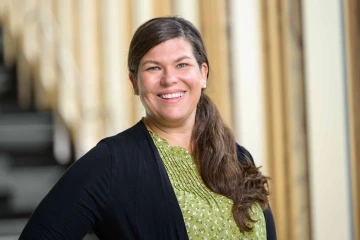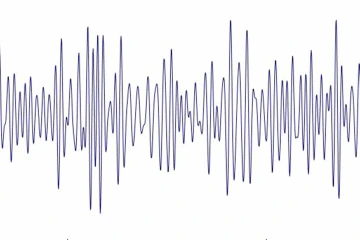Hearing the Invisible: the inspiration behind the installation
A children’s book sparked a question – can you hear brain waves? – that has grown into an immersive artistic installation opening to the public soon.

More than 5 million copies of “The Phantom Tollbooth” have been sold, including several to researcher Tally Largent-Milnes, who found scientific inspiration within the pages of the illustrated children’s book.
Photo by Noelle Haro-Gomez, U of A Health Sciences Office of Communications

Tally Largent-Milnes, PhD, led a transdisciplinary collaboration with experts at the College of Fine Arts that resulted in Hearing the Invisible, an immersive installation that allows people to hear the sounds of brain waves.
Photo by Kris Hanning, U of A Health Sciences Office of Communications
Scientists find inspiration in myriad ways: Alexander Fleming’s moldy petri dish led him to discover penicillin; Isaac Newton’s observation of an apple falling from a tree led him to write the laws of motion and the universal law of gravitation. For University of Arizona Health SciencesComprehensive Center for Pain & Addiction member Tally Largent-Milnes, PhD, a beloved children’s book sent her on a quest to hear the invisible symphony being played inside the brain.
“The Phantom Tollbooth,” written by Norton Jester and illustrated by Jules Feiffer, first published in 1961. The book tells the story of Miles, a young boy who is bored. When a mysterious tollbooth appears in his bedroom, Miles embarks on an adventure to the Lands Beyond, where he meets a ticking watchdog named Tock and sets out on a journey to save princesses Rhyme and Reason.
On the way, Miles meets Chroma the Great, “conductor of color, maestro of pigment, and director of the entire spectrum.” Chroma conducts a symphony that plays the colors of the world – violins that serenade a spring green, trumpets that blare out a blue sea, and bass fiddles that slowly, somberly play the night with silver bells to light the constellations.
“I was reading ‘The Phantom Tollbooth’ to my daughter,” said Largent-Milnes, an associate professor of pharmacology in the U of A College of Medicine – Tucson. “As I was reading a particular chapter about Chroma creating the colors of the sunset, I wondered to myself if we could do that with an EEG. Could we sonify and create a composition of an EEG so you could listen in real time?”
An EEG, or electroencephalogram, measures electrical activity in the brain. What Largent-Milnes wondered was whether it was possible to listen to brain waves.
Measuring brain activity
An EEG is a painless test in which small electrodes are attached to the scalp with adhesive and connected to a machine that records electrical activity. Many people are familiar with a similar test, an electrocardiogram, or EKG, that uses sensors to detect electrical activity in the heart.

During an EEG, multiple sensors placed on a person’s skull send information to a machine that translates the brain’s electrical impulses into visual lines.
Courtesy of Tally Largent-Milnes and Matt Flowers, U of A College of Medicine – Tucson Department of Pharmacology
In both cases, the sensors are connected to a machine that converts electrical activity into a graph of wavy lines. Doctors use the graphs to look for abnormalities. An EKG can help diagnose heart attacks, cardiomyopathy and congenital heart defects; an EEG can detect or diagnose epilepsy, sleep disorders, epilepsy, brain tumors, head injuries, brain inflammation, stoke, dementia and Alzheimer’s disease.
“With neurological diseases, by the time you can see something using magnetic resonance imaging, it’s too late to do anything. An example would be dementia, where there is a loss of brain matter,” Largent-Milnes said. “An MRI is a static image. An EEG can provide a more dynamic look at the brain, but it is still capturing a single period of time that can be influenced by your active state.”
The brain produces specific wave patterns that vary based on what a person is doing. For example, an EEG of a person sleeping will look different than an EEG of when they are awake. Seizures, brain injuries and other brain conditions also cause changes in brain wave patterns.
As Largent-Miles looked at the various waves and loops on different EEGs, she thought about Chroma using his symphony to create color. A question came to mind: what do the visual waves and loops of an EEG sound like?
“We know that even though the speed of light is faster than the speed of sound, the brain processes sound faster than light,” she said. “Also, if you are listening to music, you don’t have to have a musically trained ear to know if a guitar is out of tune – you just innately recognize that it’s not quite right.
“What if we could hear changes in the brain before we can see them?”
Composing the brain’s symphony
Originally, Largent-Milnes wanted to examine the EEGs of people with chronic pain, as that is her primary area of research. But the most comprehensive, readily available set of EEG data was for people with Alzheimer’s disease, so she started there.
A fortuitous pairing at a University of Arizona leadership training course introduced Largent-Milnes to Cynthia Stokes, MFA, an associate professor of opera in the School of Music at the U of A College of Fine Arts. Stokes’ research focus is on developing community through the power of live performance in unexpected locations using new media.
“We started talking, and I told her about my idea and asked her, ‘Can we make a musical composition out of EEG waves?’”
An EEG has many different nodes based on the recording sites on the skull. Largent-Milnes envisioned assigning a different instrument to each brain node, much like the individual instruments in Chroma’s symphony that painted the world in color.
Graduate student Matt Flowers, who works in Largent-Milnes’ lab, examined EEGs from healthy control brains, dementia brains and Alzheimer’s brains and filtered the information to five brain waves in 19 brain nodes.
Stokes and Michael Vince, who earned his Doctor of Musical Arts in Music Composition at the U of A last year, took the data from Flowers and Largent-Milnes and turned it into sound. Going one step further, they incorporated Stokes’ experience with immersive installations to create an augmented reality experience for everyone to enjoy.
Hearing the Invisible: the event
Hearing the Invisible will open to the public in mid-February in the Tornabene Theatre on the University of Arizona’s main campus in Tucson. The event will take place Thursday, Feb. 13, from 6 p.m. to 8 p.m., with a live musical performance at 7 p.m. On Friday, the exhibit will be open from 4 p.m. to 8 p.m., with a performance at 7 p.m. On Saturday, Hearing the Invisible will be open from 10 a.m. to 4 p.m. with live performances at 11:30 a.m. and 2 p.m.

Largent-Milnes hopes that by sonifying brain waves, the resulting sounds could one day lead to earlier diagnoses for invisible illnesses such as Alzheimer’s disease and chronic pain.
Courtesy of Tally Largent-Milnes and Matt Flowers, U of A College of Medicine – Tucson Department of Pharmacology
Tornabene Theatre will be converted to a multimedia representation of a brain, with images projected onto the walls and ceilings. Using headphones and digital technology, people will be able to listen to the walk through the different nodes of the brain. At each location, they will be able to listen to the sounds of healthy, dementia and Alzheimer’s brains as electronic and vocal arrangements based on the notes developed from the brain waves of the EEGs.
It is safe to say the project has grown beyond Largent-Milnes’ wildest dreams. With her idea quickly becoming reality, she is already envisioning many ways the technology could help people. For example, the sounds could educate students, patients, family members and others about the changes that are taking place in the brain.
If more research uncovers that the sounds are changing in predictable ways based on the specific disease, health professionals could listen to EEGs to identify deviations from normal.
“If we can hear the changes that are taking place in the brain sooner than we can see them, it could lead to an earlier intervention,” Largent-Milnes said. “The earlier you can intervene, the higher the chance that you can slow down or modify the disease in some way, whether it is Alzheimer’s disease, multiple sclerosis or chronic pain.”
Largent-Miles is amazed at what she, Flowers, Stokes and Vincent have been able to accomplish, all thanks to an idea that was sparked by a children’s book.
“The take-home message of ‘The Phantom Tollbooth’ is there’s a lot that you can do in life if you are open to possibilities and you see things from the different perspectives,” said Largent-Milnes, who gives a copy of the book to all of her graduate students as a final life-lesson takeaway from her lab.
“I think it really encapsulates kind of this idea of Hearing the Invisible. What does the brain actually sound like? Because it’s really just a wave. If you have a wave form, you can make a sound.”
Experts
Tally Largent-Milnes, PhD
Associate Professor, Department of Pharmacology, U of A College of Medicine – Tucson
Member, BIO5 Institute
Contact
Stacy Pigott
U of A Health Sciences Office of Communications
520-539-4152, spigott@arizona.edu

